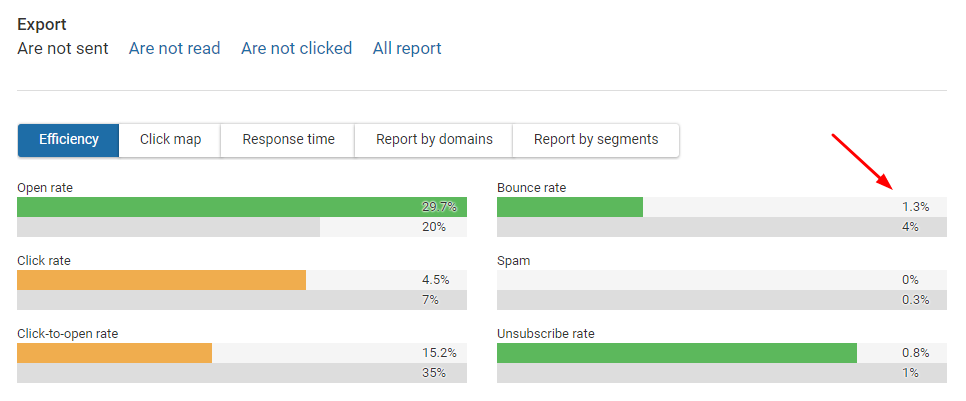Email bounce rate is one of the key metrics that must be monitored for a successful email campaign. You can use dedicated IPs and the right warm-up plan to increase your deliverability, but bounces can ruin your reputation.
In layman's terms, an email is a bounce back if it is not delivered to its intended recipient. An email bounces back due to common reasons like the change of job, abandonment of an email account, and changing ISPs. It is required by all email marketing service providers to keep the bounce rate in check.
The acceptable bounce rate (the email bounce rate threshold) is approximate 3% to 5% but does vary for every service provider. Your account may get blocked if you have hard bounce rate above 10% in most of ESPs.

An email campaign report shows the bounce rate - eSputnik Marketing Automation Software.
Why Does Your Email Bounce?
If your well-planned email campaign is flooded with high bounce rates, here are some points to consider. ASAP!
Errors in the imported list
Most email marketing services accept CSV format to import an email list. .CSV files need to be properly formatted if you see incorrect information in the email address field.
Sending emails by free email providers
DMARC authentication will fail if you send emails through a free email provider like Yahoo or Gmail. The updated DMARC policies by the majority of the email providers require an email to be sent from private domains.
Mailing to an old email list
One of the critical metrics of email marketing is to send out emails regularly. If you are mailing to a long-acquired email list, there is a high chance that some email addresses have been abandoned or converted into recycled traps due to inactivity by the inbox providers.
Un-hygienic email list
Quality over quantity is best suited for email marketing and email list. The quality of an email list accelerates an email marketing campaign. Using a scraped or purchased email list needs to be checked for its quality before you start paying for email marketing.
Type of Email Bounces & What Does it Mean?
Soft bounce = Temporary delivery failure
A soft bounce occurs when your email gets as close as the receiving mail server (the email account is recognized) and does not make it to the inbox. Here are a few reasons for the soft bounce.
- The receivers mailbox is full
- The message size is too large
- You are being blocked by the recipient
- your content shouts spam
Hard bounce = Permanent delivery failure
Hard bounce needs the most attention in your email list as it is a permanent failure and harms your sender's reputation every time you attempt to mail to such invalid addresses. You can read Hard Bounces versus Soft Bounces to better understand the difference between soft and hard bounces. Here are a few reasons for the hard bounce.
- Invalid email account
- No registered mail servers
- Typos (Yahooo instead of Yahoo)

Hard and soft bounce differences.
How to Deal With Email Bounces?
The alarming bounces from your campaigns need immediate attention. High bounce rates not only lead to account suspension but harms the marketing outcome as well. Here are the key steps to pull back your email bounces before you are up and running again. If you want to find someone's valid email address and have their first name, last name, and where he/she works, you can use DropContact.
Use the double opt-in list.
A double opt-in process is where the user needs to click on the email verification link before they are added to the list. A double opt-in can fight a lot of fake sign-ups. Also, it assures that the email is valid and the inbox is being monitored.
Keep your email list clean.
Not cleaning an email list will always result in bounces beyond specified limits. Higher bounces will have a temporary account ban (In some cases permanent) by email marketing services. Here are the benefits of a clean email list.
Don't sound like a spammer.
ISPs and inbox providers like Yahoo & Gmail have built-in advanced spam filters; an email is sent through the filters. The filter checks the message for anything spammy and sends emails to the spam box if anything is out of the ordinary.
Send email regularly
The tried and tested approach is sending out emails at least twice a month. The high-volume marketers with awesome copies and regular offers popping up send emails twice a week. But don’t forget to keep an eye on the performance of email campaigns at all times.
Removing bounces using DeBounce
The most effective method to remove bounces is to use email validation services. DeBounce can easily remove bad and invalid emails from your lists with an accuracy of +97.5%. Sign up on DeBounce, upload your list and start removing bounce emails from your list to prevent deliverability issues.
SMTP routing
SMTP routing is a very handy feature offered by Pabbly Email Marketing that can help you tackle bouncing emails. Using this feature, you can divide your long list of subscribers into smaller slots and send emails to each slot via multiple SMTP servers. Sending emails to smaller lists of subscribers avoids overloading the server, reducing email bounce. Further, it also reduces spamming of your emails and improves their deliverability.





